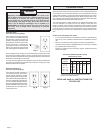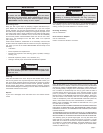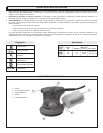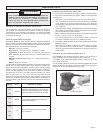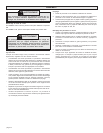
page 6
OPERATION
Starting and Stopping the Tool
To start sander, switch ON/OFF Switch to ON.
To stop sander, switch ON/OFF Switch to OFF.
General Sanding with Random Orbit Sanders
When using random orbit sanders there are a few things to keep in mind:
• Unlike most sanders, random orbit sanders should be placed on the
workpiece BEFORE the tool is started. If the sander is started before
it is placed on the workpiece, the free floating pad may be spinning
at a speed that can cause scratches when it is finally placed on
workpiece.
• Unlike most sanders, random orbit sanders can be moved across
the workpiece in any direction (in the case of wood, regardless of
the direction of the grain).
• Varying pressure applied to the sander will affect its rotating speed.
A light pressure is recommended for fine work, moderate pressure
for rough work. Excessive pressure does not allow the pad to
rotate enough.
• Keep sanding pad flat on the workpiece. Tipping the sander or using
the edges of the pad may produce an uneven finish, and reduce pad
life.
• Keep sander moving in broad even strokes across the workpiece.
Sanding in one spot too long can cause gouging and uneven results.
• Check the workpiece frequently, random orbit sanders work
more aggressively than simple orbital sanders.
Sanding
1. Place sander on the workpiece and turn on the sander.
2. Keep the sanding disc flat against the workpiece, keep the sander
moving across the workpiece, and use long, sweeping strokes.
3. Begin sanding with a coarse grit sandpaper and gradually use finer
and finer grits of sandpaper until the desired finish is reached. For
example when using the sander on wood, begin with an 80 grit
followed by a 120 grit, then a 180 grit and so on.
Removing Paint or Varnish
1. When removing several layers of paint or varnish, remove as much
as possible with a paint solvent or varnish remover.
2. Scrape away the residue with a putty knife or other scraping tool
and allow the surface to cool and dry before applying sander to the
workpiece.
3. Select a coarse grit sandpaper disc to help prevent the sandpaper
from clogging.
4. Keep the sander moving over new areas to avoid heating and soft-
ening the old coating (paint or varnish).
5. Work in wide, overlapping strokes to produce a uniform finish.
6. As the workpiece begins to show through the old coating, switch to
a medium grit sandpaper disc to avoid scratching the surface of the
workpiece. Gradually switch to a fine grit sandpaper until you achieve
the desired finish.
WARNING!
To reduce the risk of injury, wear safety goggles or glasses
with side shields. Unplug the tool before changing accesso-
ries or making adjustments.
WARNING!
Finish sanding can produce clouds of fine dust that could
ignite in the presence of sparks or open flame. Always wear
a dust mask or respirator and use your sander in a well
ventilated area.






